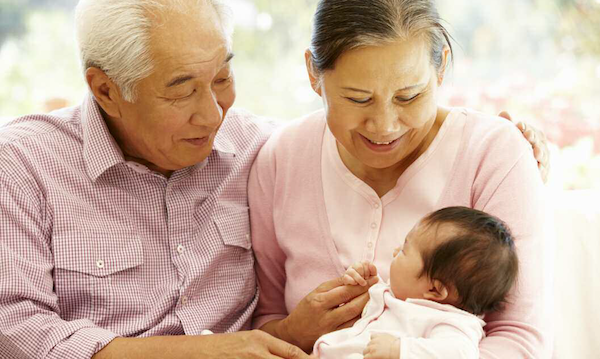The lifelong consequences of early childhood experiences
By Mary Jane Sterne and Peggy Edwards
Grandparents know intuitively that holding, soothing and speaking with babies in a loving manner are critical to a child’s well-being.We also love to engage in these activities. There is nothing better than snuggling and nuzzling with a baby, feeling their perfect skin and taking in that special “new baby” smell.
Now, we have the science to back up what we know from experience.The new science of TLC shows how tender, loving, and caring relationships help to positively shape baby’s brain. It also explains how positive or negative early childhood experiences can have lifelong consequences.
Peggy was inspired to write this column when she reviewed a new book called Baby Comes Home written by Dr. Paul Roumeliotis, a Canadian professor of pediatrics and expert on child health and wellness.
The book is a reference guide for parents, grandparents and other caregivers. It provides important baby care and safety information in the first eighteen months and beyond. This includes easy-to- find, practical detailed information on home, car and outdoor safety, nutrition, getting used to baby’s routines, stages of growth and development, and common health and illness concerns. But what intrigued me the most is the first part of the book, which provides the latest scientific explanations on the link between brain development and how we care for babies.
What do we know about brain development and early childhood care?
Babies are born with many more brain cells (neurons) than adults, and the ones that get used are the ones that remain.When a baby’s brain grows, it is actually these nerves that are forming, interconnecting and expanding. From birth to age two, a child’s brain increases from 1⁄4 to 3⁄4 the weight of an adult brain.
It is critical during this growth period that babies are in environments that allow their brains, nerve cells, connections and learning abilities to develop to their full potential.
If they do not achieve this full development, there may be long-term consequences in physical, emotional and intellectual well-being, which may appear years or even decades later. For example, young children who are neglected or abused have higher rates of heart disease and diabetes as adults than babies who have TLC and proper nutrition.
The structure of a child’s brain is shaped by the interactions between her genes and experiences. Negative factors (such as neglect) and positive factors (such as loving and caressing) can modify how and when genes get turned on or off.
A baby’s brain needs stimulation to grow to its full potential.This includes stimulating the areas of sound, vision, smell, touch, taste and proprioception (sensing one’s body position and movements). Letting baby experience new sounds, food and objects will help develop his senses and build the structure of his brain.
A child’s brain is very active. In the first few years of life, 700 new brain connections are made every second. These new connections make complex networks.These networks change over time so that the brain becomes more efficient in taking on more jobs and more complex functions.
The number of spoken words babies are exposed to influences how large their vocabulary will be by age three.The more you read and talk with baby, the more words baby hears and stores.
Connecting and playing with babies helps their brains grow and develop.When you look into his eyes and coo and smile and play peek-a-boo, you are sending signals that positively promote the vital sculpting and wiring that he needs. And voila—he smiles back.
Connecting with baby should start on day one of life. For example, the relatively new practice of skin- to-skin contact at birth has been shown to help the formation of nerve connections.
If a child’s brain development is healthy, she will be more likely to have a healthy body, to be ready for school, to learn to socialize and interact with others, and to be able to control his behaviour.
Soothing and building a secure and trusting relationship with a baby helps him deal with stress, fear and illness by promoting a healthy brain, nerve and hormonal structure.
Children who grow up in poor and deprived environments can become healthy and successful adults IF they receive lots of TLC, reading, bonding and stimulation. The opposite is also true. Babies in rich families who do not get the attention, stimulation and TLC they need may end up with negative mental, behavioural, emotional and physical consequences. How can grandparents help ensure that our precious newborns have the best beginning possible? • Share this information with their parents and with friends who have grandbabies on the way.
Offer a home environment that is safe, smoke-free, warm and nurturing so that parents will feel comfortable leaving baby with us in order to have some needed time away to do errands, catch up on sleep or spend time alone together.
Make every effort to spend loving time with grandchildren in the first six to 18 months, even if it means travelling to visit.
Take the time to hold and caress and play with them.
Share the wonder of experiencing new smells, sounds, tastes, colours and movement.
Speak with them, sing to them, read to them. Some grandparents who can’t do this in person use Skype, talk on the phone and send recordable storybooks.
Be part of baby’s extended community of relationships and connections. Communal TLC and attention promotes optimal brain development and overall wellness later in life.
Learn more about early child development and share this knowledge with our adult children and older grandchildren — the potential and new parents in our lives (See Resources).
The bottom line? Ensuring a long, healthy and happy life starts by fostering and providing the best beginning possible. It does not cost anything to nurture, caress, respond to and give attention to babies.The benefits to baby and the pleasure we adults get back is priceless! ■
Peggy Edwards and Mary Jane Sterne are best friends and the authors of “Intentional Grandparenting:A Boomer’s Guide” (McClelland and Stewart, 2005). Available from your favourite bookstore or online at www.chapters.indigo.ca. The authors live in Ottawa and have 23 grandchildren and 5 great grandchildren between them.







